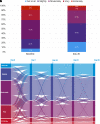Relationship between Self-reported Sleepiness and Positive Airway Pressure Treatment Adherence in Obstructive Sleep Apnea
- PMID: 37126852
- PMCID: PMC10405605
- DOI: 10.1513/AnnalsATS.202206-482OC
Relationship between Self-reported Sleepiness and Positive Airway Pressure Treatment Adherence in Obstructive Sleep Apnea
Abstract
Rationale: Positive airway pressure (PAP) is the first-choice treatment for obstructive sleep apnea (OSA). However, its real-world effectiveness is often questioned because of usage issues. The relationship between patient sleepiness and PAP usage has been assessed in relatively small and selected populations within the research context. Objectives: To assess the impact of patient-reported sleep outcomes, particularly self-reported sleepiness and its change during therapy, on PAP usage in the real-world setting. Methods: Deidentified data for U.S.-based patients receiving PAP therapy were examined. Eligible patients were registered in the myAir app and provided self-reported sleepiness at baseline and after 7, 14, 21, and 28 days of PAP between November 2019 and April 2020. Results: A total of 95,397 registered patients met all eligibility criteria and were included in the analysis (mean age, 49.6 ± 13.0 yr; 61.6% male). Daytime sleepiness was the most common reason for PAP therapy initiation (57.1% of patients), and 42.2% of all patients had self-reported moderate to severe OSA. Self-reported sleepiness improved with PAP therapy in most patients over the assessment period, with 62.1% of patients reporting "no" or "slight" sleepiness at Day 28. There was a dose-dependent association between improvement in self-reported sleepiness at Day 28 and PAP usage, and this finding was maintained at Day 360. Self-reported sleepiness at Day 28 was associated with achieving U.S. Centers for Medicare & Medicaid Services compliance at 90 days (approximately 90% for those with no or slight sleepiness vs. <70% for those with residual very or extreme sleepiness); average daily PAP usage over 360 days was ⩾5.0 and ⩽3.7 hours, respectively, for those with no or slight versus very or extreme sleepiness. Conclusions: This study demonstrates the feasibility of capturing patient-reported outcomes via a digital platform. Patient-reported outcomes appear to be associated with PAP usage, especially self-reported sleepiness and its response to therapy. Capturing patient-reported outcomes using digital solutions during the course of treatment has the potential to enhance patient outcomes by providing actionable insights.
Keywords: adherence; obstructive sleep apnea; patient-reported outcomes; positive airway pressure therapy; sleepiness.
Figures



References
-
- Jenkinson C, Davies RJ, Mullins R, Stradling JR. Comparison of therapeutic and subtherapeutic nasal continuous positive airway pressure for obstructive sleep apnoea: a randomised prospective parallel trial. Lancet . 1999;353:2100–2105. - PubMed
-
- Labarca G, Saavedra D, Dreyse J, Jorquera J, Barbe F. Efficacy of CPAP for improvements in sleepiness, cognition, mood, and quality of life in elderly patients with OSA: systematic review and meta-analysis of randomized controlled trials. Chest . 2020;158:751–764. - PubMed
-
- Labarca G, Schmidt A, Dreyse J, Jorquera J, Enos D, Torres G, et al. Efficacy of continuous positive airway pressure (CPAP) in patients with obstructive sleep apnea (OSA) and resistant hypertension (RH): systematic review and meta-analysis. Sleep Med Rev . 2021;58:101446. - PubMed
Publication types
MeSH terms
Grants and funding
LinkOut - more resources
Full Text Sources
Research Materials
Miscellaneous

